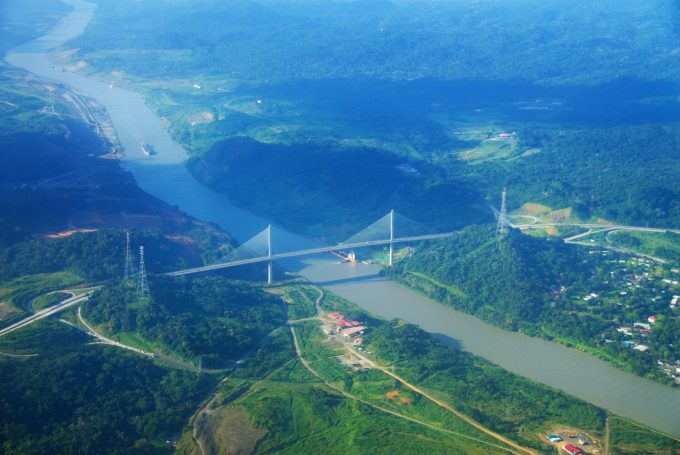Maersk Frankfurt heads for open water as container fire subsides
Maersk Frankfurt, the newbuild box ship that suffered a possible electrical fault and subsequent container ...
TFII: SOLID AS USUALMAERSK: WEAKENINGF: FALLING OFF A CLIFFAAPL: 'BOTTLENECK IN MAINLAND CHINA'AAPL: CHINA TRENDSDHL: GROWTH CAPEXR: ANOTHER SOLID DELIVERYMFT: HERE COMES THE FALLDSV: LOOK AT SCHENKER PERFORMANCEUPS: A WAVE OF DOWNGRADES DSV: BARGAIN BINKNX: EARNINGS OUTODFL: RISING AND FALLING AND THEN RISING
TFII: SOLID AS USUALMAERSK: WEAKENINGF: FALLING OFF A CLIFFAAPL: 'BOTTLENECK IN MAINLAND CHINA'AAPL: CHINA TRENDSDHL: GROWTH CAPEXR: ANOTHER SOLID DELIVERYMFT: HERE COMES THE FALLDSV: LOOK AT SCHENKER PERFORMANCEUPS: A WAVE OF DOWNGRADES DSV: BARGAIN BINKNX: EARNINGS OUTODFL: RISING AND FALLING AND THEN RISING

The Panama Canal Authority (ACP) is to further reduce the maximum draft allowed for vessels transiting the waterway during an especially severe drought season, obliging ocean carriers to lighten the loads of Asia – US east coast Panama and Pendulum loops.
As a result, transpacific carriers are set to impose hefty surcharges from 1 June for shipments on Asia – US east coast all water services and redirect some of their loops via the Suez Canal.
“The Panama drought season is causing draft issues in the canal, reducing the Panama string capacity,” said Maersk in its monthly market update.
Meanwhile, Hapag-Lloyd said that it would implement a PCC (Panama Canal Charge) of $500 per container effective 1 June on all cargo loaded on its Asia to US east coast sailings via the canal.
“The lower-than-usual water levels in the Gatun Lake are causing severe draft restrictions on vessels transiting the Panama Canal,” said Hapag-Lloyd in a customer advisory.
The harsh drought season has resulted in the level of the Gatun Lake, the largest of the two lakes feeding the Canal, falling faster than predicted after rainfall between February and April was less than half the average for the period.
An advisory to shipping issued by the ACP said that the maximum draft allowed for vessels transiting the Canal from 24 May would be reduced to 13.56m or 44.5 ft.
“In addition, effective 30 May, the maximum authorised draft allowed for vessels transiting the neopanamax locks will be 13.41m (44 ft),” said the advisory.
“The ACP will continue to monitor the level of the Gatun Lake and announce future draft adjustments in a timely manner,” it added.
Commenting on the transpacific Asia – US east coast tradelane, Maersk said that the network was “imbalanced” with some services fully booked while others were underutilised.
The coastal shift of cargo from US west coast ports to ports on the Atlantic coast has increased at pace since the opening of the expanded Panama Canal in 2016, which enabled ships of around 13,000 teu (new panamax) to transit the waterway, compared to the previous restrictions limiting the size of vessels to around 4,500 teu (panamax), thus substantially improving the voyage economics for shipping lines.
Indeed, according to the latest McCown Report analysing the performance of the top 10 US container ports in April, east and Gulf Coast terminals handled 887,950 teu of container imports last month, compared to 812,611 teu of boxes imported at US west coast ports.
Moreover, the Port of New York & New Jersey has now overtaken Long Beach to be the second-busiest US port for imports and is fast catching the number one port of Los Angeles.
“April was the 23rd straight month where the percentage change in volume at east / Gulf Coast ports outperformed west coast ports,” said the report’s author John McCown.
However, with freight rates increasing for the Asia – US east coast shipments, due to the draft restrictions this summer, US west coast ports could stand to recover some of their lost business, particularly if the reports of an imminent deal in the long-running west coast labour negotiations prove to be correct.
Comment on this article
JukurrpaShip ShipBuilders
June 25, 2023 at 12:39 amAs an entity that have transited Panama 13 times, it’s sad to see it’s natural demise.
From a commercial climatic perspective, the Canal’s issues are reflected globally.
We comment as a builder of non-containerised tonnage. It is easy to see that even with no water restrictions both Suez and Panama would struggle with Cellular 50,000 TEU vessels and above.
This means a ‘digital canal’ will be required, through the likes of Egypt and Mexico where the old Suez and old Panama will essentially service ‘feeder’ ship capacity.